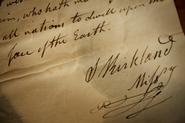
Two hundred years of learning is undoubtedly cause for celebration. Yet the charter that Hamilton received in 1812 merely continued a quest for knowledge that had begun two decades earlier with Samuel Kirkland and his Hamilton-Oneida Academy, a secondary school that focused on educating local Iroquois youth. Like so much at Hamilton, the Academy began with a piece of writing: Kirkland’s 1791 “Plan of Education for the Indians,” a 15-page document in which Kirkland outlined his ideas for the new school.
The document itself is about six inches wide by seven inches tall—a size that truly belies its stature. Kirkland’s plan is currently on loan from Dartmouth College and in the care of Christian Goodwillie, the director of special collections for the Burke Library. Goodwillie and his staff in the Patricia Pogue Couper Rare Book Room (3rd floor of Burke Library) will be hosting a program on Thursday, Sept. 22, highlighting Kirkland’s life and written legacy, where visitors will be able to inspect and handle several of Kirkland’s personal effects. Later this semester the “Plan of Education” will be on view in the library.
Publius Virgilus Rogers Professor of History Maurice Isserman regards Kirkland’s plan as “the founding document of Hamilton College” because it created the school “out of which the college developed.” Isserman, who is widely regarded as an authority on Hamilton’s history, has recently published On the Hill: A Bicentennial History of Hamilton College, which traces the evolution of the college from Kirkland’s vision through modern times.
Kirkland stressed from the beginning that the students of the Academy should “be instructed in reading and writing the English and Indian languages,” and stated that “the utility of teaching [the Indians] to read and write in their own language is very obvious,” establishing an emphasis on written communication that Hamilton continues today. Writing well, however, was only one facet of the proposed curriculum. In an excerpt from his book, Isserman states:
“In addition to learning to speak, read, and write English, and do basic arithmetic, the Indian students would also be instructed in ‘the principles of human nature, and the history of civil society.’”
There was also an emphasis placed on practical education. Kirkland believed that students should receive instruction in agriculture and husbandry, and mandated that a one-acre farm be included on the school’s grounds for that purpose. Today’s 1812 Garden and Community Farm manage to carry on this tradition as well—although the focus has shifted from animal husbandry to organic and sustainable food production. Ultimately, Kirkland hoped that the graduates of the Academy would spread their knowledge among the people of the Iroquois, underlining Hamilton’s belief that knowledge is most useful when in the service of the greater good.
The Academy was meant to succeed where other “Indian schools” had failed. By locating the school in Clinton, Kirkland consciously placed it on the border between colonial America and the lands of the Six Nations of the Iroquois. He hoped the school’s location would ease the Iroquois youths into European culture rather than forcibly removing them from their native surroundings in the way many other schools did. Kirkland stressed that parents of the students should be able to visit frequently in order to “have the gratification of seeing [the students’] improvement and [to] encourage them by their applause.” Family Weekend, it seems, is not a modern invention.
It is apparent from his writing that Kirkland established the Academy because he truly wanted to serve the native people of the area. Although he does refer to them as “savages” and does consciously speak of “civilizing the Indians,” he does not regard them as sub-human, the way many educated Europeans and Americans did.
Rather, as Kirkland states in the plan, he “cannot yet admit the idea, which some have advanced, that there is a repugnancy in the very frame and constitution of [Indian’s] minds to intellectual improvement and the art of civilized life…the difference between one nation and another is not so much owing to nature as to education.”
For all his sound planning and aspirations, the Hamilton-Oneida Academy never quite reached the heights that Kirkland had hoped. “The law of unintended consequences applies here,” Isserman said. “Things don’t always work out as one expects.” Kirkland died in 1808, four years before the Academy was refigured into the College.
Perhaps the legacy of the “Plan for Education” and by extension, the legacy of the Academy, was best elucidated by Kirkland himself: “That it [the plan for education] will be productive of happy consequences in a civil, moral and political view will not be doubted.”
Despite a perceived failure in the short term, Kirkland’s spirit of intellectual inquiry and community service has lived on in every student that has set foot on College Hill in the past two centuries. A “happy consequence” indeed.
